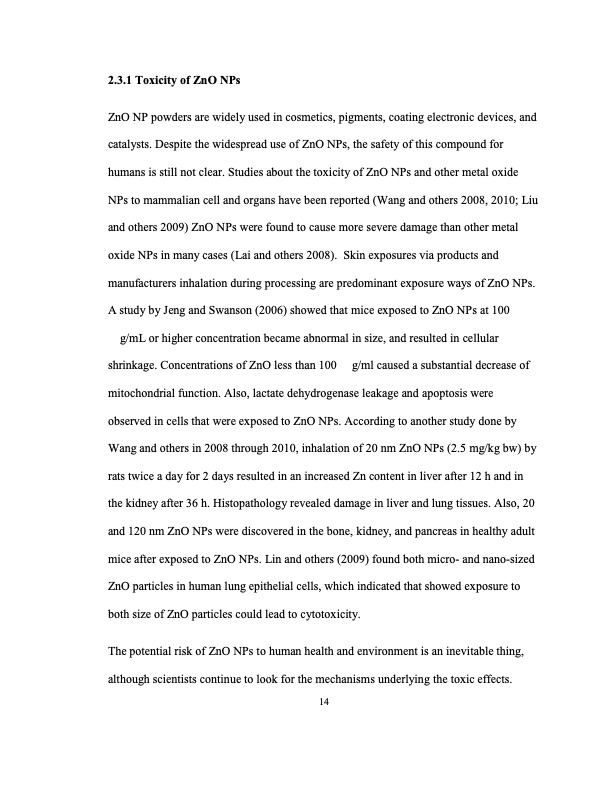
PDF Publication Title:
Text from PDF Page: 025
2.3.1 Toxicity of ZnO NPs ZnO NP powders are widely used in cosmetics, pigments, coating electronic devices, and catalysts. Despite the widespread use of ZnO NPs, the safety of this compound for humans is still not clear. Studies about the toxicity of ZnO NPs and other metal oxide NPs to mammalian cell and organs have been reported (Wang and others 2008, 2010; Liu and others 2009) ZnO NPs were found to cause more severe damage than other metal oxide NPs in many cases (Lai and others 2008). Skin exposures via products and manufacturers inhalation during processing are predominant exposure ways of ZnO NPs. A study by Jeng and Swanson (2006) showed that mice exposed to ZnO NPs at 100 g/mL or higher concentration became abnormal in size, and resulted in cellular shrinkage. Concentrations of ZnO less than 100 g/ml caused a substantial decrease of mitochondrial function. Also, lactate dehydrogenase leakage and apoptosis were observed in cells that were exposed to ZnO NPs. According to another study done by Wang and others in 2008 through 2010, inhalation of 20 nm ZnO NPs (2.5 mg/kg bw) by rats twice a day for 2 days resulted in an increased Zn content in liver after 12 h and in the kidney after 36 h. Histopathology revealed damage in liver and lung tissues. Also, 20 and 120 nm ZnO NPs were discovered in the bone, kidney, and pancreas in healthy adult mice after exposed to ZnO NPs. Lin and others (2009) found both micro- and nano-sized ZnO particles in human lung epithelial cells, which indicated that showed exposure to both size of ZnO particles could lead to cytotoxicity. The potential risk of ZnO NPs to human health and environment is an inevitable thing, although scientists continue to look for the mechanisms underlying the toxic effects. 14PDF Image | ZINC OXIDE AND SILVER NANOPARTICLES ON INTESTINAL BACTERIA

PDF Search Title:
ZINC OXIDE AND SILVER NANOPARTICLES ON INTESTINAL BACTERIAOriginal File Name Searched:
thesis-zinc-oxide-silver-nano.pdfDIY PDF Search: Google It | Yahoo | Bing
Turbine and System Plans CAD CAM: Special for this month, any plans are $10,000 for complete Cad/Cam blueprints. License is for one build. Try before you buy a production license. More Info
Waste Heat Power Technology: Organic Rankine Cycle uses waste heat to make electricity, shaft horsepower and cooling. More Info
All Turbine and System Products: Infinity Turbine ORD systems, turbine generator sets, build plans and more to use your waste heat from 30C to 100C. More Info
CO2 Phase Change Demonstrator: CO2 goes supercritical at 30 C. This is a experimental platform which you can use to demonstrate phase change with low heat. Includes integration area for small CO2 turbine, static generator, and more. This can also be used for a GTL Gas to Liquids experimental platform. More Info
Introducing the Infinity Turbine Products Infinity Turbine develops and builds systems for making power from waste heat. It also is working on innovative strategies for storing, making, and deploying energy. More Info
Need Strategy? Use our Consulting and analyst services Infinity Turbine LLC is pleased to announce its consulting and analyst services. We have worked in the renewable energy industry as a researcher, developing sales and markets, along with may inventions and innovations. More Info
Made in USA with Global Energy Millennial Web Engine These pages were made with the Global Energy Web PDF Engine using Filemaker (Claris) software.
Infinity Turbine Developing Spinning Disc Reactor SDR or Spinning Disc Reactors reduce processing time for liquid production of Silver Nanoparticles.
| CONTACT TEL: 608-238-6001 Email: greg@infinityturbine.com | RSS | AMP |